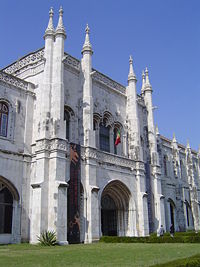
National Archaeology Museum (Lisbon)
Encyclopedia

Lisbon
Lisbon is the capital city and largest city of Portugal with a population of 545,245 within its administrative limits on a land area of . The urban area of Lisbon extends beyond the administrative city limits with a population of 3 million on an area of , making it the 9th most populous urban...
, Portugal
Portugal
Portugal , officially the Portuguese Republic is a country situated in southwestern Europe on the Iberian Peninsula. Portugal is the westernmost country of Europe, and is bordered by the Atlantic Ocean to the West and South and by Spain to the North and East. The Atlantic archipelagos of the...
. It is one of the most important Portuguese museums dedicated to Archaeology
Archaeology
Archaeology, or archeology , is the study of human society, primarily through the recovery and analysis of the material culture and environmental data that they have left behind, which includes artifacts, architecture, biofacts and cultural landscapes...
.
The museum was founded in 1893 by notable archaeologist José Leite de Vasconcelos
José Leite de Vasconcelos
José Leite de Vasconcelos Cardoso Pereira de Melo was a Portuguese ethnographer and prolific author who wrote extensively on Portuguese philology and prehistory...
, and since 1903 it occupies the Western wing of the Jerónimos Monastery
Jerónimos Monastery
The Hieronymites Monastery is located near the shore of the parish of Belém, in the municipality of Lisbon, Portugal...
, in the Belém district. The building of the museum used to be the dormitory of the monks, and was redecorated in neo-Manueline
Manueline
The Manueline, or Portuguese late Gothic, is the sumptuous, composite Portuguese style of architectural ornamentation of the first decades of the 16th century, incorporating maritime elements and representations of the discoveries brought from the voyages of Vasco da Gama and Pedro Álvares Cabral...
style in the second half of the 19th century. The museum is the most important centre for archaeological research in Portugal, and has a collection of finds from the whole country.
At the entrance there are two granite
Granite
Granite is a common and widely occurring type of intrusive, felsic, igneous rock. Granite usually has a medium- to coarse-grained texture. Occasionally some individual crystals are larger than the groundmass, in which case the texture is known as porphyritic. A granitic rock with a porphyritic...
statues of Lusitanian Warriors
Lusitanians
The Lusitanians were an Indo-European people living in the Western Iberian Peninsula long before it became the Roman province of Lusitania . They spoke the Lusitanian language which might have been Celtic. The modern Portuguese people see the Lusitanians as their ancestors...
, dating from the 1st century AD and brought from Northern Portugal. The permanent exhibits are divided into Egyptian Antiques
Ancient Egypt
Ancient Egypt was an ancient civilization of Northeastern Africa, concentrated along the lower reaches of the Nile River in what is now the modern country of Egypt. Egyptian civilization coalesced around 3150 BC with the political unification of Upper and Lower Egypt under the first pharaoh...
and a collection of Treasures of Portuguese Archaeology, consisting mostly of notable metalwork dating from the Bronze
Bronze Age
The Bronze Age is a period characterized by the use of copper and its alloy bronze as the chief hard materials in the manufacture of some implements and weapons. Chronologically, it stands between the Stone Age and Iron Age...
and Iron Age
Iron Age
The Iron Age is the archaeological period generally occurring after the Bronze Age, marked by the prevalent use of iron. The early period of the age is characterized by the widespread use of iron or steel. The adoption of such material coincided with other changes in society, including differing...
s. The museum also possesses the most important Portuguese collection of Roman
Roman Empire
The Roman Empire was the post-Republican period of the ancient Roman civilization, characterised by an autocratic form of government and large territorial holdings in Europe and around the Mediterranean....
mosaics, mostly from Southern Portugal, but also from "Estremadura" (Póvoa de Cós
Póvoa de Cós
Póvoa de Cós is a place located in the center of Portugal. It is part of the district of Leiria.Belonging to the county of Alcobaça, it depends on the civil parish of Cós...
) in the Centre.
Apart from its permanent collection, the museum often organises temporary exhibitions covering several subjects.
See also
- Jerónimos MonasteryJerónimos MonasteryThe Hieronymites Monastery is located near the shore of the parish of Belém, in the municipality of Lisbon, Portugal...
- Maritime MuseumMaritime Museum (Lisbon)The Navy Museum of Lisbon is dedicated to all aspects of the History of navigation in Portugal. The museum is administered by the Portuguese Navy and is located in the touristic district of Belém...
- Carmo Archaeological MuseumCarmo Convent (Lisbon)The Carmo Convent is a historical building in Lisbon, Portugal. The mediaeval convent was ruined in the 1755 Lisbon Earthquake, and the ruins of its Gothic church are the main trace of the great earthquake still visible in the city.The Carmo Convent is located in the Chiado neighbourhood, on a...

